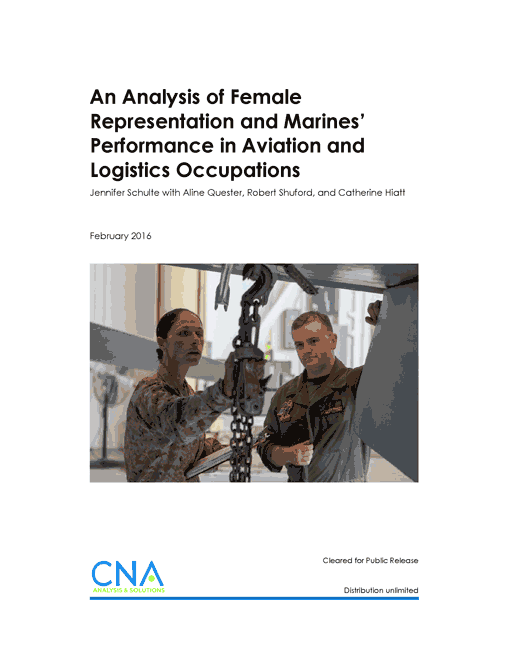In 2013, the Secretary of Defense rescinded the 1994 Direct Ground Combat Definition and Assignment Rule, opening ground-combat-related military service opportunities to women [1]. In response, the Marine Corps created the Marine Corps Force Innovation Office (MCFIO) to gather research on gender integration and implement the Marine Corps’ integration plan. This report is one part of CNA’s efforts for MCFIO. This report analyzes the Marine Corps’ experience with integration between FY 1987 and FY 2014 to inform expectations about whether and how to integrate combat occupations. We examine gender trends in recruit requirements, retention, and promotions in these occupational communities to highlight factors the Marine Corps should focus on when determining whether and how to open ground combat occupations to women.
In this report, we examine trends in female representation as well as performance differences between men and women for FY 1987 through FY 2014 using Marine Corps personnel data. Our analysis focuses on Marines who held primary military occupational specialties (PMOSs) in any of the aviation occupational fields (occfields) (60XX through 75XX) or the logistics occfield (04XX). We focus on the aviation occupations because (1) the Marine Corps opened the pilot/naval flight officer (NFO) occfield (75XX) to female officers in 1993 and (2) women have been underrepresented in these occupations relative to their overall representation in the Marine Corps. In comparison, the majority of logistics (04XX) occfield PMOSs have been open to female Marines since the 1970s, and women have been relatively overrepresented in this occfield.
Our findings about Marine officers in the aviation and logistics occfields are as follows:
- Female officers are less likely than male officers to have flight aptitude ratings (FARs) that qualify them for the pilot/NFO pipeline.
- Female pilot/NFO students complete flight training at lower rates than male pilot/NFO students. For both men and women, NFO students, those with FARs above the minimum requirement, and those who were not in the bottom third of their classes at The Basic School were the most likely to complete flight training.
- O3-O5 selection rates are similar for men and women within an occupational group (ground logistics, non-pilot/non-NFO aviation, and pilot/NFO), which suggests that male and female officers are equally qualified for these ranks.
- Female officers are less likely than male officers to reach 10 years of commissioned service. The retention gender gap is larger in the aviation occfields than in the ground logistics occfields, which suggests that retention varies across occupations as well as gender.
Our findings about enlisted Marines in the aviation and logistics occfields are as follows:
- In general, female enlisted Marines have lower scores than male enlisted Marines on the technical sections of the Armed Services Vocational Aptitude Battery. This implies that a lower percentage of female recruits, relative to male recruits, will be eligible for technical occupations, such as aviation PMOSs.
- E4-E6 promotion probabilities are similar for men and women within an occfield, but women are more likely than men to be fast promoters (being in the top third of promoters ranked by number of months to promotion).
These findings indicate that enlisted women in ground logistics and aviation occupations are just as qualified as enlisted men, if not more qualified.
- Enlisted women have higher first-term attrition rates than men. The firstterm attrition rate gender gap is larger in the ground logistics occfields than in the aviation occfields. Beyond the first term, enlisted women have lower attrition rates than men.
Recruits’ propensity to serve in an occupation has a direct effect on female representation, and the speed at which newly opened PMOSs are integrated will depend on the Marine Corps’ ability to recruit women into them. This report is not able to address these topics, but we recommend that they be part of the Marine Corps’ long-term integration analysis plan. When considering and planning for the opening of occupations to women, Marine Corps manpower plans should incorporate differences in men’s and women’s abilities to meet occupation qualifications and in their continuation rates. The Marine Corps could use current open PMOSs that require similar skills as the PMOSs being considered for integration to estimate these effects. Understanding these effects is important for maintaining viable career paths and avoiding the creation of gaps in leadership. To better understand gender differences in retention rates, the Marine Corps’ longer-term analysis plan should include analysis of why Marines transition from the Marines Corps. The systematic collection of data through exit surveys or interviews will give the Marine Corps insights into the factors that affect men’s and women’s retention decisions and will determine whether it should implement mitigating practices or policies.
Download reportDistribution unlimited. Specific authority: N00014-11-D-0323
Details
- Pages: 96
- Document Number: DRM-2014-U-008649-1REV
- Publication Date: 2/1/2016
